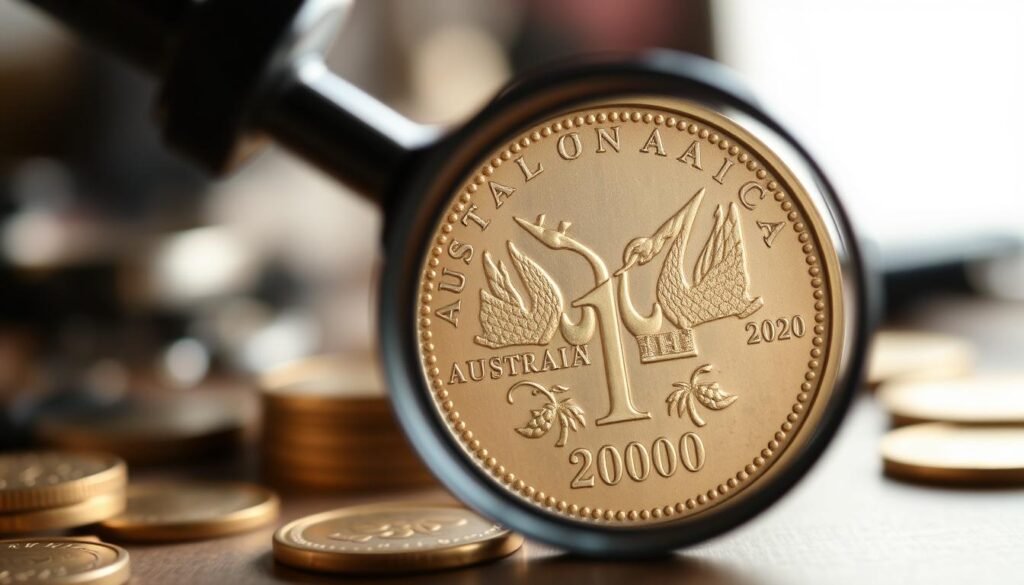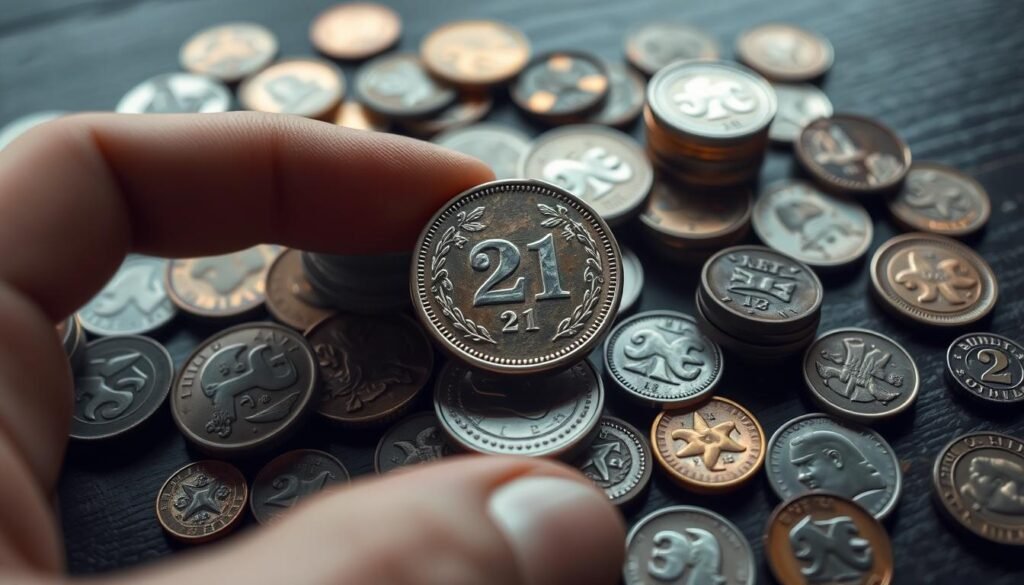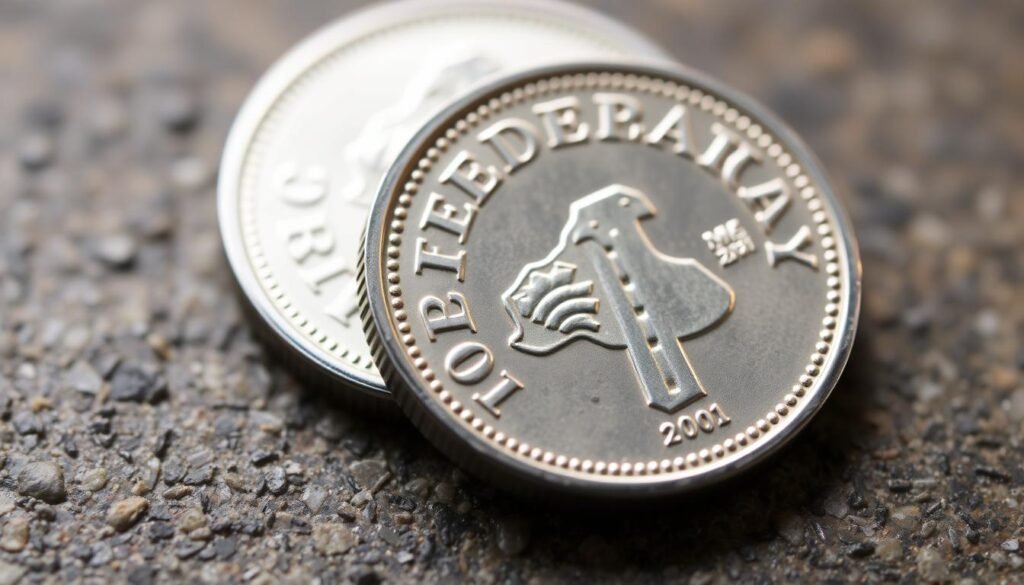Imagine finding a $1 coin that could be worth up to $1,000. This is the story of the 2000 $1 mule coin. It’s a rare find from the Royal Australian Mint, known for its tiny error.
The 2000 $1 mule coin was made by mistake. The Royal Australian Mint accidentally put a 10 cent piece’s design on a $1 coin. This created a unique border around the design. Despite being made in large numbers, only about 20,000 were produced. This makes them very rare and sought after by collectors.
Major Highlights
- The 2000 $1 mule coin can fetch up to $1,000 in uncirculated condition due to its rarity.
- Tens of thousands of mules were struck, but only around 20,000 were produced, making them highly coveted by collectors.
- Circulated examples of the 2000 $1 mule coin may be worth $200-$300, while uncirculated specimens command significantly higher prices.
- The PCGS grading system, which rates coins up to MS/PR70, considers the MS64 grade of the 2000 $1 mule coin as exceptionally rare.
- A dedicated collector in Perth, Australia, found 180 examples of the 2000 $1 mule coin in poker machine coin bins over two years, highlighting the unexpected discoveries.
The Historic 2000 $1 Coin Mule: A Modern Australian Numismatic Treasure
The 2000 $1 mule coin is a rare gem in Australian coins. It was made by mistake, with a 10 cent die used instead of the usual $1 coin die. This error has made it a favorite among collectors and coin lovers.
Understanding the Mule Error
In numismatics, a “mule” is a coin with the wrong reverse die. The 2000 $1 mule coin was made at the Royal Australian Mint. It has a unique secondary border on its reverse.
Mint Production Details
How many 2000 $1 mule coins were made is unknown. Estimates range from 400 to 6,000. This mystery makes the coin even more sought after.
Initial Discovery and Public Response
In 2003, someone found the 2000 $1 mule coin. This sparked a big search across Australia. People were looking for this rare coin in their change.
As one collector said, “The discovery of the 2000 $1 mule coin has shaken up the Australian numismatic community. It reminds us that even today, there are hidden treasures to find.”
The excitement for the 2000 $1 mule coin is ongoing. Collectors and dealers are always hoping to find more. This rare coin has won the hearts of many in Australia, showing the lasting charm of the country’s coins.
How to Identify the Valuable 2000 $1 Coin
The 2000 $1 coin is a rare and valuable Australian treasure. It’s known as the “mule” error. To spot this coin, look for a secondary border on the front side. The back should have the usual $1 design.
Checking if a coin is real is very important. These rare coins can sell for a lot in the collector market.
Professional grading services like the Professional Coin Grading Service (PCGS) can help. They check the coin’s details and condition. This is key when buying expensive coins online, where it’s hard to know if they’re real.
- Identifying the secondary border on the obverse side is a telltale sign of the 2000 $1 mule coin
- The reverse should have the standard $1 die strike, without any additional features
- Seek professional grading services like PCGS to verify the coin’s authenticity and condition
- Be cautious when acquiring rare coins through online platforms, as expert examination is essential
Knowing the 2000 $1 mule coin’s unique features helps collectors. Using professional services to check coins ensures they’re real. This way, collectors can buy with confidence.

The Value of Circulation vs Uncirculated Mule Coins
In the world of numismatics, the rare 2000 $1 mule coin from Australia has caught the eye of many. These unique coins are estimated to be in the tens of thousands. But their value can change a lot based on their condition and grading.
Pricing Guide for Different Conditions
Mule coins found in regular circulation can be worth $200 to $300. But uncirculated ones can be much more valuable. On platforms like eBay, prices range from $995 to $6,500. The higher prices depend on the coin’s condition and grading.
PCGS Grading Impact on Value
The Professional Coin Grading Service (PCGS) is key in setting the value of these rare coins. Out of the estimated 20,000 mule coins made, only five got a PCGS MS64 grade. Most are in private collections. This scarcity greatly affects their value in the numismatic market.
Market Trends and Recent Sales
The demand for the 2000 $1 mule coin is growing. Collectors and investors are eager to find these rare coins. In Perth, Western Australia, one collector found 180 mules in two years by searching coin bins. This shows the effort needed to find these coin valuation treasures.
| Condition | Value Range |
|---|---|
| Circulated | $200 – $300 |
| Uncirculated | $995 – $6,500 |
| PCGS MS64 Grade | Extremely Rare |
The growing interest and demand for these rare mule coins suggest their value will keep going up. They are becoming a valuable part of any serious coin collection.
The Great Australian Coin Hunt: Stories of Discovery
The discovery of the 2000 $1 mule coin set off a coin collecting craze in Australian numismatics. People searched everywhere for this treasure hunting find. They looked in bank bags, store tills, and even school canteen change.
In Perth, one collector found 180 mule coins over two years. They looked in poker machine coin bins. Even now, over 20 years later, they keep searching for this rare coin.
“I’ve been searching through every bank bag and till I can get my hands on, and it’s been an incredible journey. The hunt for the 2000 $1 mule is like searching for buried treasure – you never know when you might stumble upon the prize.”
The 2000 $1 mule coin’s story has drawn in many coin collectors in Australia. It has inspired a new wave of numismatics fans. The excitement of finding something rare and the joy of owning a piece of history keep the hunt alive.

Understanding PCGS Grading System for $1 Coins
The Professional Coin Grading Service (PCGS) is a top coin grading service worldwide. They have graded over 35 million coins from all over. Their Sheldon Coin Grading Scale, a 1-70 point system, is the standard for coin quality.
For Australian $1 coins, the PCGS system offers valuable insights. But, its grading might differ from the local system. PCGS uses colours like MS66RD for Gem Uncirculated coins. Australian collectors often use their own terms like Uncirculated and Gem Uncirculated.
The PCGS population report shows how rare a coin is. It helps understand a coin’s value. Just one MS point can change a coin’s price by thousands of dollars. You can find this report on the PCGS website for Australian coins.
| PCGS Grade | Adjectival Description | Copper Coin Designation |
|---|---|---|
| MS60-63 | Uncirculated | – |
| MS64 | Choice Uncirculated | – |
| MS65+ | Gem Uncirculated | Red, Brown, or Red/Brown |
PCGS grading ensures a coin’s authenticity. Each coin comes with a unique certificate number. But, fake slabs from Asia have made buyers check coins and certificates carefully.
Understanding PCGS grading helps Australian collectors. They can buy rare $1 coins like the 2000 Mule. This ensures they get genuine, high-quality coins.
The 2001 Federation $1 Coin Rotation Error
The 2001 Centenary of Federation $1 coin is a hit among Australian coin collectors. Some coins have a special feature – a rotation error. This error makes the coin look “upset” because the heads and tails sides aren’t perfectly aligned.
Identifying Rotation Errors
To spot a rotation error on a 2001 Federation $1 coin, just flip it. Look at the Queen’s head. If it’s not straight up (at 12 o’clock) but at 3 o’clock, you’ve found a valuable coin.
Current Market Values
These error coins are highly wanted by collectors. They can sell for a lot more than their face value. On eBay, prices range from $26 to $75, based on the coin’s condition.
The error happened because of a problem with the die during making. This let one die rotate slightly before striking. So, the heads and tails sides got misaligned, making a unique error coin.
| Coin Condition | Rotation Error Value |
|---|---|
| Uncirculated | $55 – $75 |
| Circulated | $26 – $50 |
The 2001 Federation $1 coin rotation error is a cool example of minting errors. For those who collect Australian coin errors, these coins are a must-have.

Authentication and Verification Methods for Rare Coins
For numismatic fans and investors, checking the authenticity of rare coins is key. The Professional Coin Grading Service (PCGS) and Numismatic Guaranty Corporation (NGC) are top names in this field. They use strict checks to look at a coin’s state, metal, and other important details. This gives a clear view that the market trusts.
When buying valuable coins online, it’s smart to look for those graded by PCGS or NGC. This confirms the coin’s realness and shares its exact grade, which affects its worth. Working with these trusted groups helps collectors and investors feel sure about their purchases.
There are also ways to spot fake coins. You can weigh, measure, and check if they’re magnetic. Looking closely at the coin’s surface under a microscope helps too. By using these methods and the help of experts, collectors can confidently grow their collections with real, valuable coins.


Hey there I have some rare coins where can I sell.Thank you Fatima.